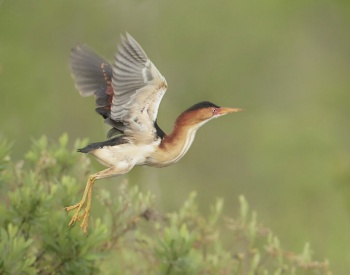(All sections started. References. Video link. Incomplete gone) |
(Genus change. References & GSearch updated.) |
||
| (6 intermediate revisions by 3 users not shown) | |||
| Line 1: | Line 1: | ||
| − | [[Image:Least_Bittern.jpg|thumb| | + | [[Image:Least_Bittern.jpg|thumb|400px|right|Photo © by {{user|Marcel+Gauthier|Marcel Gauthier}} <br />Lacolle, Quebec, [[Canada]], June 2005]] |
| − | ;[[:Category: | + | ;[[:Category:Botaurus|Botaurus]] exilis |
| + | ''Ixobrychus exilis'' | ||
==Identification== | ==Identification== | ||
| − | 28–36 cm | + | [[Image:Least Bittern Chick Anahuac.jpg|thumb|350px|right|Chick, subspecies ''exilis''<br />Photo © by {{user|Stanley+Jones|Stanley Jones}}<br />[[Anahuac National Wildlife Refuge]], Chambers County, [[Texas]], [[USA]], July 2018]] |
| + | 28–36 cm (11-15 in)<br /> | ||
| + | Adult male | ||
| + | *Blackish cap | ||
| + | *Buff to tawny-chestnut face and neck-sides | ||
| + | *White chin, throat and underparts, with buff-brown streaks | ||
==Distribution== | ==Distribution== | ||
| − | [[North America|North]] and [[South America]]. | + | [[North America|North]] and [[South America]]. <br /> |
'''Breeds''' in much of the eastern and southern [[USA]] and extreme south-east [[Canada]]. Scarce and local in the west breeding from southern [[Oregon]] to [[California]]. Breeds widely through [[Mexico]] and [[Central America]] and in [[South America]] from [[Colombia]], [[Venezuela]], [[Trinidad]] and the [[Guianas]] to southern [[Brazil]] and [[Uruguay]]. Also occurs in a narrow coastal belt of [[Peru]]. | '''Breeds''' in much of the eastern and southern [[USA]] and extreme south-east [[Canada]]. Scarce and local in the west breeding from southern [[Oregon]] to [[California]]. Breeds widely through [[Mexico]] and [[Central America]] and in [[South America]] from [[Colombia]], [[Venezuela]], [[Trinidad]] and the [[Guianas]] to southern [[Brazil]] and [[Uruguay]]. Also occurs in a narrow coastal belt of [[Peru]]. | ||
| Line 13: | Line 19: | ||
==Taxonomy== | ==Taxonomy== | ||
====Subspecies==== | ====Subspecies==== | ||
| − | + | [[Image:4F80315C-F620-43E6-BCA5-817748ACC6FC.jpeg|thumb|350px|right|Photo © by {{user|Kadawe|Kadawe}}<br />[[Massachusetts]], 30 May 2020]] | |
| − | * | + | Six subspecies are recognised<sup>[[#References|[1]]]</sup>: |
| − | *''pullus'': | + | *''B.e. exilis'': |
| + | :*[[North America]] | ||
| + | *''B.e. pullus'': | ||
:* (darker above) on the Sonora and Sinaloa coast of [[Mexico]] | :* (darker above) on the Sonora and Sinaloa coast of [[Mexico]] | ||
| − | *''bogotensis'': | + | *''B.e. bogotensis'': |
:* (richly-coloured underparts and blacker legs) in central [[Colombia]] | :* (richly-coloured underparts and blacker legs) in central [[Colombia]] | ||
| − | *''erythromelas'': | + | *''B.e. erythromelas'': |
:* (more rufous above) over most of South American range | :* (more rufous above) over most of South American range | ||
| − | *''peruvianus'': | + | *''B.e. limoncochae'' |
| + | :*eastern [[Ecuador]]; records from northeastern [[Peru]] (Loreto) presumably also this subspecies | ||
| + | *''B.e. peruvianus'': | ||
:* (duller) on the coast of [[Peru]] | :* (duller) on the coast of [[Peru]] | ||
==Habitat== | ==Habitat== | ||
| Line 29: | Line 39: | ||
Their diet consists of small fish and aquatic insects, also dragonflies and grasshoppers. | Their diet consists of small fish and aquatic insects, also dragonflies and grasshoppers. | ||
==References== | ==References== | ||
| − | #{{Ref- | + | #{{Ref-Clements6thOct24}}#Handbook of the Birds of the World Alive (retrieved June 2014) |
{{ref}} | {{ref}} | ||
==External Links== | ==External Links== | ||
| − | {{GSearch|Ixobrychus | + | {{GSearch|"Botaurus exilis" {{!}} "Ixobrychus exilis" {{!}} "Least Bittern"}} |
| + | {{GS-checked}}1 | ||
<br /> | <br /> | ||
| − | + | <br /> | |
| − | [[Category:Birds]][[Category: | + | |
| + | [[Category:Birds]][[Category:Botaurus]] | ||
Latest revision as of 23:14, 18 February 2025
- Botaurus exilis
Ixobrychus exilis
Identification

Photo © by Stanley Jones
Anahuac National Wildlife Refuge, Chambers County, Texas, USA, July 2018
28–36 cm (11-15 in)
Adult male
- Blackish cap
- Buff to tawny-chestnut face and neck-sides
- White chin, throat and underparts, with buff-brown streaks
Distribution
North and South America.
Breeds in much of the eastern and southern USA and extreme south-east Canada. Scarce and local in the west breeding from southern Oregon to California. Breeds widely through Mexico and Central America and in South America from Colombia, Venezuela, Trinidad and the Guianas to southern Brazil and Uruguay. Also occurs in a narrow coastal belt of Peru.
Northern birds are migratory and winter in the southern USA, Mexico and the West Indies.
Recorded as a vagrant once in Iceland ( on Heimaey in the Westmann Islands in September 1970) and 5 times in the Azores, all September-November, and also an unconfirmed report from Britain.
Taxonomy
Subspecies
Six subspecies are recognised[1]:
- B.e. exilis:
- B.e. pullus:
- (darker above) on the Sonora and Sinaloa coast of Mexico
- B.e. bogotensis:
- (richly-coloured underparts and blacker legs) in central Colombia
- B.e. erythromelas:
- (more rufous above) over most of South American range
- B.e. limoncochae
- B.e. peruvianus:
- (duller) on the coast of Peru
Habitat
Marshy areas with dense vegetation, sometimes brackish waters.
Behaviour
Diet
Their diet consists of small fish and aquatic insects, also dragonflies and grasshoppers.
References
- Clements, J. F., P. C. Rasmussen, T. S. Schulenberg, M. J. Iliff, T. A. Fredericks, J. A. Gerbracht, D. Lepage, A. Spencer, S. M. Billerman, B. L. Sullivan, M. Smith, and C. L. Wood. 2024. The eBird/Clements checklist of Birds of the World: v2024. Downloaded from https://www.birds.cornell.edu/clementschecklist/download/
- Handbook of the Birds of the World Alive (retrieved June 2014)
Recommended Citation
- BirdForum Opus contributors. (2025) Least Bittern. In: BirdForum, the forum for wild birds and birding. Retrieved 12 May 2025 from https://www.birdforum.net/opus/Least_Bittern
External Links
GSearch checked for 2020 platform.1





